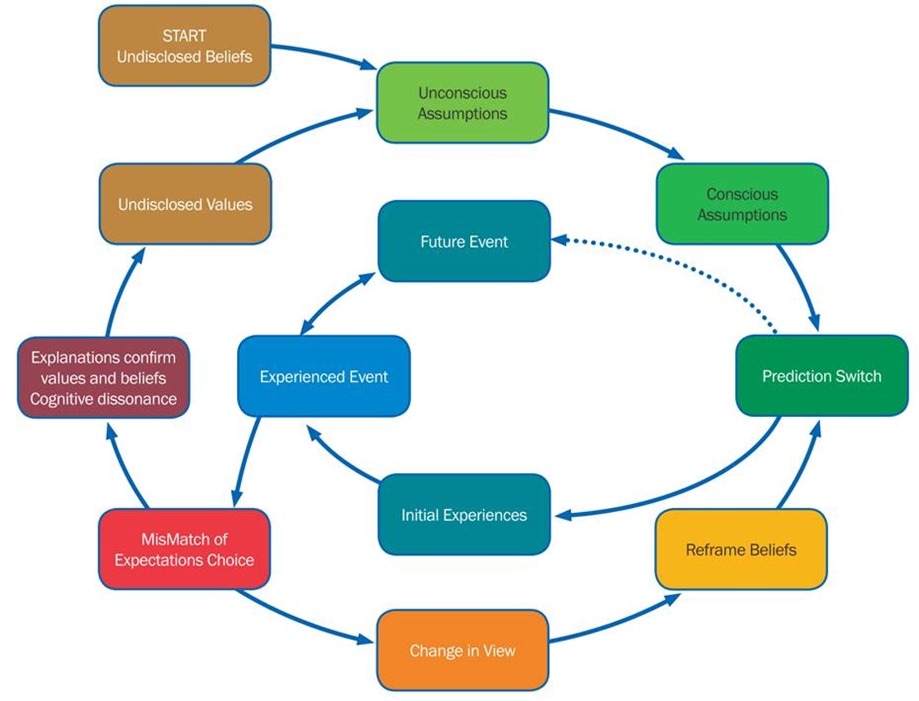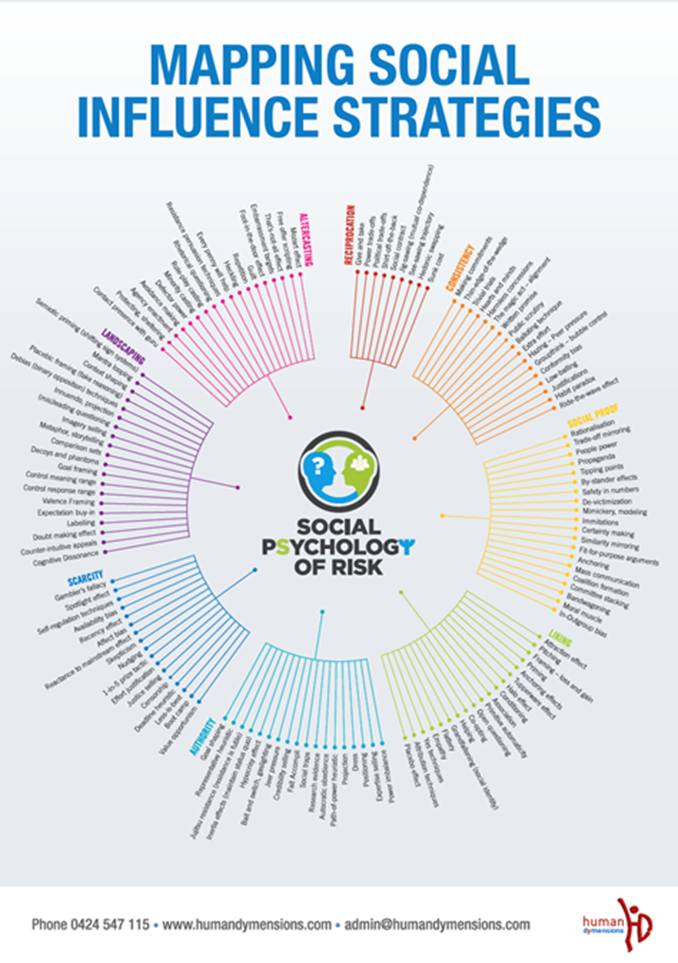Originally posted on September 29, 2021 @ 11:14 AM
Cognitive Dissonance and Safety Beliefs
Whenever we run the Introduction to the Social Psychology of Risk (SPoR) Module (https://cllr.com.au/product/an-introduction-to-the-social-psychology-of-risk-unit-1-free-online-module/ ) we always struggle at the start with the suspension of belief, unlearning safety myths and new learning in SPoR. The next free course will be available in Feb 2022.
We have just started the sixth group this year who are undertaking the module and the shifting of belief is always a challenge. Even in the introductions to each other we can hear how safety has ‘anchored’ people to various myths common to safety orthodoxy. Such as:
- Zero ideology
- Safety is a choice you make
- Safety is about engineering
- All accidents are preventable
- Injury rates equate to safety
- Safety is objective
- Paperwork is effective in managing risk
- Safety tools are effective
- Culture is what we do around here
When we started the first session this week with the Language Audit, it came out ‘we’ve been brainwashed’. Brain washing is an interesting term but I’d prefer the idea of ‘mis-educated’ or ‘indoctrinated’. And this is no one fault, it is how the industry has evolved so much so that the global industry is anchored to the delusional ideology of zero. You couldn’t find anything more delusional that the ‘Spirit of Zero’ presentation (https://visionzero.global/videos ).
However, those who sign up and register for the free module must already have started to doubt the traditional safety narrative and its accompanied myths. This is how one escapes from the Cognitive Dissonance cycle. See Figure 1. Cognitive Dissonance Cycle.
Figure 1. Cognitive Dissonance Cycle.
More on the graphic later.
Cognitive Dissonance was first explained by Leon Festinger . Festinger (1919-1989) is one of the pioneers in Social Psychology. Festinger didn’t represent his idea of Cognitive Dissonance semiotically hence why I developed the Cognitive Dissonance Cycle as a map. I explain the map here: https://vimeo.com/202589604.
Cognitive Dissonance is most often misunderstood as cognitive discomfort but this is not what was conveyed by Festinger. Cognitve Dissonance is not about a change in ideas. Indeed, the nature of breaking away from cultic belief is most associated with deep and painful distress associated with loss in identity and being. Cognitive Dissonance is not just about a shift in ideas but is most associated with the psychology of conversion and distress in identity. The shifting of worldviews is also associated with identity to a group, belonging to a group and a schismatic upheaval in movement away from the cult. There is little difference between breaking away from a religious cult or the zero cult.
The best way to start an understanding of Cognitive Dissonance is to study the nature of cults and the psychology of conversion. In this regard Mary Douglas is a good starting point; or Mircea Eliade or perhaps Hexam and Poewe .
A study of cults also helps one in an understanding of cult-ure. This is especially important as the safety industry also maintains the mythology that culture is about behaviours. So, what is a cult? How is it identified?
- At the heart of the cult is religious discourse ‘anchored’ identity-belief,
- The cult creates identity to itself by sacrifice, belonging, grammatical code and reward,
- The cult anchors the language of ‘faith’ to ‘belief’ through symbol-myth as established truth,
- The cult creates belonging against a binary ‘other’,
- Demonization of ‘the enemy’, reinforces identity to the cult,
- The cult holds faith in rituals that confirm faith in the cult,
- Cults maintain prophetic belief and predictive discourse.
All of these characteristics are clearly present in the zero cult. The language of the cult is always about belief against the presence of reality, in denial of fallibility. Believe the impossible.
- https://safetyrisk.net/safety-as-faith-healing/
- https://safetyrisk.net/believe-the-impossible-and-speak-nonsense-to-people/
- https://safetyrisk.net/the-shape-of-belief-in-safety/
Who could forget the big banners at the Global Safety Convention in 2017 ‘We Believe’ (https://safetyrisk.net/zero-vision-as-propaganda/; https://safetyrisk.net/no-evidence-for-the-religion-of-zero/ ). See Figure 2. ‘We Believe’
Figure 2. ‘We Believe’
Just look at the throng of believers at the zero cult convention in 2017 and tell me safety is not a cult. Just look at the video Spirit of Zero (https://safetyrisk.net/the-spirit-of-zero/) and tell me zero is not a cult.
So, now we know why it is nearly impossible to shift cultic affirmations once the cult has been made the foundation of belief.
Let now look at the Cognitive Dissonance Cycle.
The first thing we should note is the nature of flow and movement between each stage of the cycle. Each one of these transitions between states involves a host of social psychological influences (see Figure 3. Social Influence) (You can download the Social Influence map here: https://spor.com.au/downloads/posters/
Figure 3. Social Influence
Many of these social influences play a critical role in each transition in the Cognitive Dissonance Cycle.
It is when these transitions are broken by doubt that we begin preparation to resist Cognitive Dissonance. (Take note of the movement in transitions in the cycle). It is in doubt, questioning and critical thinking (all negated by the zero cult) that we become prepared to shift in identity and accept the pain of movement away from the cult. The crisis comes at the red stage when prediction mismatch becomes so powerful that one is prepared to jettison nonsense curves, matrices and safety myths that are espoused as effective. The moment one doubts zero is the moment a new journey starts, the moment one moves away from the zero cult, safety improves (https://safetyrisk.net/moving-away-from-zero-so-that-safety-improves/ ). The initial movement is slow but at some stage comes a cataclysmic moment when one realizes that one has been brainwashed and is ready for new learnings
You can read a case study here of how this happens here: https://www.humandymensions.com/product/it-works-a-new-approach-to-risk-and-safety/
Once safety indoctrination has been jettisoned through resisting Cognitive Dissonance then a new framing, discourse and learning journey commences, a journey that is less cultic, less dehumanizing and less brutal.
Such a shift can be quite lonely if one was not offered a new community, new tools and new support and this is offered through SPoR. In SPoR one moves away from the cult of brutalism towards a new approach to humanizing safety.






Do you have any thoughts? Please share them below